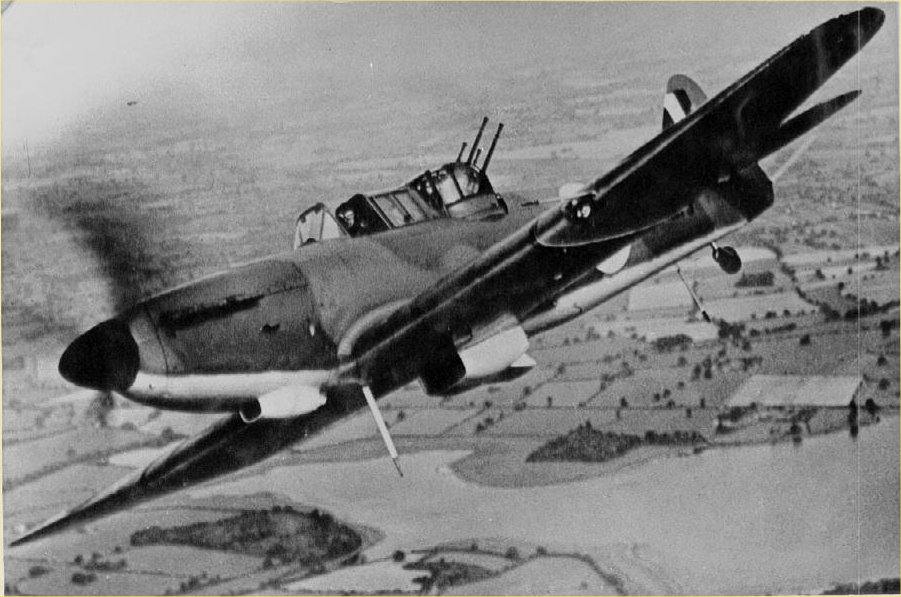
Posted on 05/26/2020 10:03:12 AM PDT by C19fan
A World War II aircraft which was sent to a museum in 1944 was far deadlier than its reputation suggests, according to a historian. The Boulton Paul Defiant had a Rolls Royce Merlin engine - just like the acclaimed Spitfire and Hurricane - but it also had a second seat with a machine gun turret for blasting enemy bombers out of the sky. When it was first introduced into service, Luftwaffe pilots initially mistook the aircraft for a Hurricane and would attempt to roll in behind the aircraft to shoot it down only to be faced by its deadly Browning .303 machine guns.
(Excerpt) Read more at dailymail.co.uk ...
An interceptor with no capability for firing forward. Brilliant.


Amusingly, the story has a caption on one of the images that the aircraft had a crew of two “people”.
Blame the government specification, not the plane or its designers, for that.
AHEM!!!! Bf109, thank you very much.
And the Bf109 wasn’t without flaws either - in particular it barely had enough range to reach Great Britain. As such, whatever bombers it was escorting to British airspace were vulnerable once the Bf109’s had to turn back.
bfl
Knew a Polish POW who was in Stalag 13 (yeah, I know) in Nuremberg. He told me the Spitfires would take out an entire city block in one run.
Woke up one morning soon afterward, and all the guards had left.
Historical revisionism is regularly attacked, but often it helps us discover new truths. In WW2 aviation, for example, recent research has helped upgrade the value delivered by the p-40 Warhawk and the B-24.
It killed a lot of planes. Especially as a night fighter. The leading Japanese ace Saburo Sakai was nearly killed by some Grumman Avengers. He rolled in on them from the rear thinking they were Wildcats, when his windshield exploded. A ball turret gunner shot him in the head.
There was a learning curve at the beginning of the war. The Germans thought the Stuka was badass, they terror of Europe, until they tried to use them over England one day.
And people laugh, but late in the war German night fighters used the same general concept to attack bombers. It was an early version of a useful idea.
Very true on the P-40 and B-24.
” In 1943 the 325th won two major engagements. On July 1, 22 checker-tailed P-40s were making a fighter sweep over southern Italy when they were jumped by 40 Bf-109s. After an intense air battle, the result was half of the German aircraft shot down for the loss of a single P-40. There was a similar situation on the 30th of July, again over Italy, when 35 Bf-109s ambushed 20 P-40s. On this occasion, 21 German fighters were shot down, again for the loss of a single P-40. Because the pilots of the 325th were trained to maximize the P-40’s strengths and minimize its weaknesses, it became a lethal opponent for the German fighters. The final record of “The Checker-Tailed Clan’s” P-40s was 135 Axis planes shot down (96 were Bf-109s), for only 17 P-40s lost in combat.”
The other draw back to the Me 109 was it’s cockpit. It had a blind spot to the left and right rear.
Bookmark
“That plane was a sitting duck for ME-109s. Waste of Merlin engines on that air frame.”
The Defiant holds the record for shooting down the most enemy aircraft in one day when on May 29, 1940, 264 Squadron shot down two Me 109s, 15 Me 110s and a Junkers Ju 87 Stutka dive bomber on their first mission of the day.
After refuelling and rearming, the squadron finished the day with a total of 38 aircraft kills.
Although, one of the squadron’s aces - having killed five aircraft in one day - was later shot down and killed.
Pilot Nicholas Cooke and his gunner Albert Lippett scored five kills in one day, making them instant Aces.
There was some Japanese fighter which had a gun installed behind the pilot pointing upward at a fixed 45 degree angle. It would drift in behind a flight of bombers above and let lose from below. Apparently, the bombers seldom knew from where the attack was coming until it was too late.
The USA had a lot of .50 cal Brownings flying around. B-24s had ten each. Japanese pilots considered it suicide to attack even small formations. They’d attack the bombers to bring in the cover, then fight them. Often, a US fighter would fly past the formation to have a tailing Zero removed.
IIRC, it was Claire Chennault (Flying Tiger fame) and his pilots who developed those tactics for their P-40’s. They dove on fighters/bombers for a firing pass and then pulled up into a zoom climb to regain altitude. Rinse and repeat. Avoid dogfighting against opponents with superior maneuverability (e.g., Zeros or BF-109’s).
Germans used the same concept in their night fighters; usually pairs of cannon fixed to fire forward and up at 30 degrees. Took advantage of poor ventral defensive armament in British bombers. They called it Schrage Muzik (jazz, or literally “slanted” music).
Disclaimer: Opinions posted on Free Republic are those of the individual posters and do not necessarily represent the opinion of Free Republic or its management. All materials posted herein are protected by copyright law and the exemption for fair use of copyrighted works.